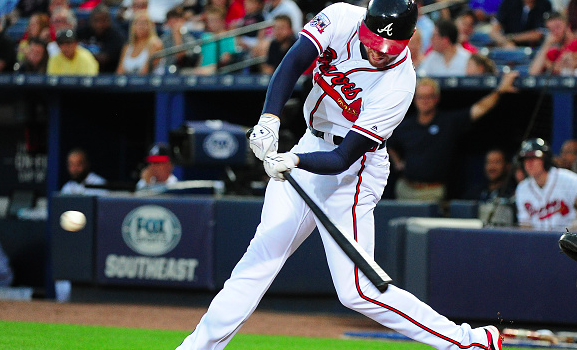As the Atlanta Braves continued selling off MLB talent to rebuild for the future last winter, general manager John Coppolella was adamant about one thing: first baseman Freddie Freeman wasn’t going anywhere.
Fast-forward to a few months later as the left-handed hitter wraps up a career year and everyone can see why he’s worth every penny of that $135 million contract. Enjoying such a performance was probably the furthest thing from Freeman’s mind after a rough first two months, though.
By the end of May, he was just hoping to get hot and dig himself out of a slow start. While Atlanta’s offense as a whole was historically bad, Freeman also struggled to a .251/.338/.419 triple slash with eight home runs and 15 RBI.
Then, the first baseman caught fire – he’s hitting .335/.435/.654 with 25 homers and 73 RBI since June 1, including a ridiculous 1.249 OPS through 82 at-bats in September.
The biggest sign of growth in Freeman’s game has been his power. His 33 homers and .980 OPS are currently career highs, while his 43 doubles are tied for a career high. This has produced a 6.2 fWAR, which ranks within the top 10 in all of baseball.
So, how did he do it? Not exactly the same way as most young sluggers tap into their power potential.
Three examples of hitters who have recently taken their respective games to the next level include Nolan Arenado, Bryce Harper and Jose Altuve. We already talked about what Arenado has accomplished, while Altuve basically took a page out of Harper’s book to unlock power we never realized was there.
The one common denominator found among these three? Increased plate discipline. Each swung at less pitches out of the strike zone (and less pitches overall). And when they did swing, there was a greater chance of doing damage.
What makes Freeman’s power surge unique is he did the opposite with his plate approach, yet has experienced similar results.
Prior to 2016, Freeman’s best season was his All-Star campaign of 2013. He finished fifth in National League MVP voting and hit .319/.396/.501 with 23 homers and 109 RBI (all of which were new career highs). He did it by swinging at more pitches (inside and outside the zone) than the average big league hitter:
The 2014 and 2015 seasons were solid, but not all that close to the potential he flashing in ’13. Freeman produced a collective .283/.379/.465 line during that time, while hitting 36 homers (18 in each year) and driving in 144 runs.
His plate discipline improved, but he didn’t see the kind of results hitters like Altuve, Harper and Arenado experienced:
Now, look at how these numbers changed in 2016:
Not only is he swinging more often, but his contact rates are the lowest of all the years we’ve investigated. In fact, his 72.6 percent contact rate from 2016 is the lowest it’s ever been in his career.
As if him swinging at more pitches overall wasn’t weird enough, right? He’s still been successful because his batted ball numbers have returned to their 2013 levels. His 43.4 percent hard-hit rate is a career high, but his batting average on ground balls (.242), fly balls (.325) and line drives (.767) are more in line with his performance from four seasons ago.
The acquisition of Matt Kemp has helped transform the Braves from one of baseball’s worst offenses to one of baseball’s best. However, that transformation began prior to Kemp’s arrival and because Freeman put the team on his back.
With a 64-92 record and only a handful of games left to play, it was a tough season for the organization, but it wasn’t all bad. One of the biggest positives was their first baseman’s career year as Atlanta looks to build an offense with him as the anchor.
Freeman’s path toward returning to All-Star level production wasn’t the same as some of his peers. But in a results-based business, that doesn’t matter. What matters is producing, which is what he’s done at a high level in 2016.
And it affirms that Coppolella was right in keeping him untouchable in any potential trade talks.
Statistics courtesy of Baseball-Reference. Advanced statistics courtesy of FanGraphs unless otherwise noted.
Thanks for reading! If you’d like to jumpstart your sportswriting career and aren’t sure how, check out my eBook. Don’t forget to follow me on Twitter so we can chat about baseball: @mmusico8.
Add The Sports Daily to your Google News Feed!

